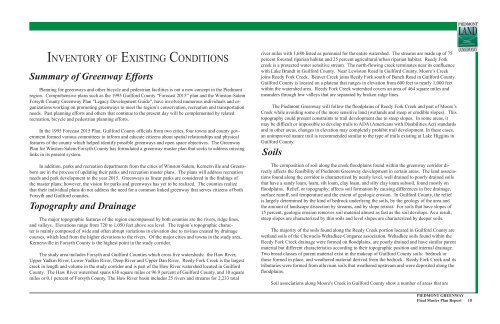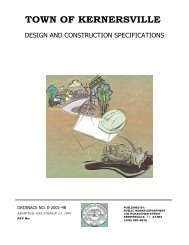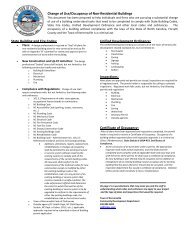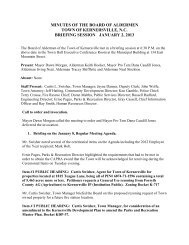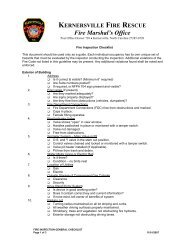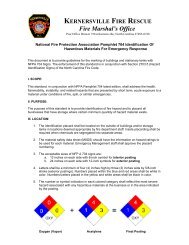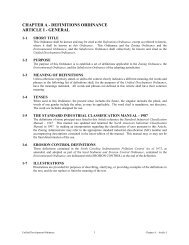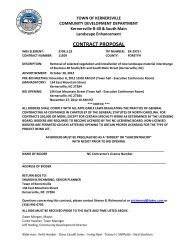Piedmont Greenway Master Plan - Town of Kernersville
Piedmont Greenway Master Plan - Town of Kernersville
Piedmont Greenway Master Plan - Town of Kernersville
- No tags were found...
Create successful ePaper yourself
Turn your PDF publications into a flip-book with our unique Google optimized e-Paper software.
INVENTORY OF EXISTING CONDITIONS<br />
Summary <strong>of</strong> <strong>Greenway</strong> Efforts<br />
<strong>Plan</strong>ning for greenways and other bicycle and pedestrian facilities is not a new concept in the <strong>Piedmont</strong><br />
region. Comprehensive plans such as the 1995 Guilford County “Forecast 2015” plan and the Winston-Salem<br />
Forsyth County <strong>Greenway</strong> <strong>Plan</strong> "Legacy Development Guide", have involved numerous individuals and organizations<br />
working on promoting greenways to meet the region’s conservation, recreation and transportation<br />
needs. Past planning efforts and others that continue to the present day will be complemented by related<br />
recreation, bicycle and pedestrian planning efforts.<br />
In the 1995 Forecast 2015 <strong>Plan</strong>, Guilford County <strong>of</strong>ficials from two cities, four towns and county government<br />
formed various committees to inform and educate citizens about spatial relationships and physical<br />
features <strong>of</strong> the county which helped identify possible greenways and open space objectives. The <strong>Greenway</strong><br />
<strong>Plan</strong> for Winston-Salem/Forsyth County has formulated a greenway master plan that seeks to address missing<br />
links in its present system.<br />
In addition, parks and recreation departments from the cities <strong>of</strong> Winston-Salem, <strong>Kernersville</strong> and Greensboro<br />
are in the process <strong>of</strong> updating their parks and recreation master plans. The plans will address recreation<br />
needs and park development to the year 2015. <strong>Greenway</strong>s as linear parks are considered in the findings <strong>of</strong><br />
the master plans; however, the vision for parks and greenways has yet to be realized. The counties realize<br />
that their individual plans do not address the need for a common linked greenway that serves citizens <strong>of</strong> both<br />
Forsyth and Guilford counties.<br />
Topography and Drainage<br />
The major topographic features <strong>of</strong> the region encompassed by both counties are the rivers, ridge lines,<br />
and valleys. Elevations range from 720 to 1,050 feet above sea level. The region’s topographic character<br />
is mainly composed <strong>of</strong> wide and <strong>of</strong>ten abrupt variations in elevation due to ravines created by drainage<br />
courses, which lead from the higher elevations to the rivers. Of the major cities and towns in the study area,<br />
<strong>Kernersville</strong> in Forsyth County is the highest point in the study corridor.<br />
The study area includes Forsyth and Guilford Counties which cross five watersheds: the Haw River,<br />
Upper Yadkin River, Lower Yadkin River, Deep River and Upper Dan River. Reedy Fork Creek is the largest<br />
creek in length and volume in the study corridor and is part <strong>of</strong> the Haw River watershed located in Guilford<br />
County. The Haw River watershed spans 638 square miles or 96.9 percent <strong>of</strong> Guilford County, and 10 square<br />
miles or 0.1 percent <strong>of</strong> Forsyth County. The Haw River basin includes 25 rivers and streams for 2,233 total<br />
river miles with 1,680 listed as perennial for the entire watershed. The streams are made up <strong>of</strong> 75<br />
percent forested riparian habitat and 25 percent agricultural/urban riparian habitat. Reedy Fork<br />
creek is a protected water sensitive stream. The north-flowing creek terminates near its confluence<br />
with Lake Brandt in Guilford County. Near Lewiston Road in Guilford County, Moore’s Creek<br />
joins Reedy Fork Creek. Beaver Creek joins Reedy Fork south <strong>of</strong> Bunch Road in Guilford County.<br />
Guilford County is located on a plateau that ranges in elevation from 600 feet to nearly 1,000 feet<br />
within the watershed area. Reedy Fork Creek watershed covers an area <strong>of</strong> 464 square miles and<br />
meanders through low valleys that are separated by broken ridge lines.<br />
The <strong>Piedmont</strong> <strong>Greenway</strong> will follow the floodplains <strong>of</strong> Reedy Fork Creek and part <strong>of</strong> Moore’s<br />
Creek while avoiding some <strong>of</strong> the more sensitive land (wetlands and steep or erodible slopes). This<br />
topography could present constraints to trail development due to steep slopes. In some areas, it<br />
may be difficult or impossible to develop trails to ADA (Americans with Disabilities Act) standards<br />
and in other areas, changes in elevation may completely prohibit trail development. In these cases,<br />
an unimproved nature trail is recommended similar to the type <strong>of</strong> trails existing at Lake Higgins in<br />
Guilford County.<br />
Soils<br />
The composition <strong>of</strong> soil along the creek floodplains found within the greenway corridor directly<br />
affects the feasibility <strong>of</strong> <strong>Piedmont</strong> <strong>Greenway</strong> development in certain areas. The land associations<br />
found along the corridor is characterized by nearly level, well drained to poorly drained soils<br />
that have a sandy loam, loam, silt loam, clay loam, and silty clay loam subsoil, found mostly on<br />
floodplains. Relief, or topography, affects soil formation by causing differences in free drainage,<br />
surface run<strong>of</strong>f, soil temperature and the extent <strong>of</strong> geologic erosion. In Guilford County, the relief<br />
is largely determined by the kind <strong>of</strong> bedrock underlying the soils, by the geology <strong>of</strong> the area and<br />
the amount <strong>of</strong> landscape dissection by streams, and by slope retreat. For soils that have slopes <strong>of</strong><br />
15 percent, geologic erosion removes soil material almost as fast as the soil develops. As a result,<br />
steep slopes are characterized by thin soils and level slopes are characterized by deeper soils.<br />
The majority <strong>of</strong> the soils found along the Reedy Creek portion located in Guilford County are<br />
wetland soils <strong>of</strong> the Chewacla-Wehadkee-Congaree association. Wehadkee soils found within the<br />
Reedy Fork Creek drainage were formed on floodplains, are poorly drained and have similar parent<br />
material but different characteristics according to their topographic position and internal drainage.<br />
Two broad classes <strong>of</strong> parent material exist in the makeup <strong>of</strong> Guilford County soils: bedrock or<br />
those formed in place, and weathered material derived from the bedrock. Reedy Fork Creek and its<br />
tributaries were formed from alluvium soils that weathered upstream and were deposited along the<br />
floodplains.<br />
Soil associations along Moore's Creek in Guilford County show a number <strong>of</strong> areas that are<br />
PIEDMONT GREENWAY<br />
Final <strong>Master</strong> <strong>Plan</strong> Report 10


